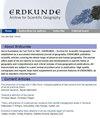Geographical proximity vs network tie: innovation of equipment manufacturing firms in Shanghai, China
IF 1.1
4区 社会学
Q3 GEOGRAPHY
引用次数: 6
Abstract
Recent theoretical arguments and empirical studies in economic geography have emphasized the importance of both geographical proximity and network tie for firm innovation. However, few studies have empirically assessed the effects of these two together. This paper examines and compares the effects of geographical proximity and network tie on innovation based on a unique dataset of equipment manufacturing firms in Shanghai, China. An extended spatial economic model is adopted for this analysis. We find evidence that network ties rather than geographical proximity promote firm innovation. This finding is different from previous studies using region as unit of analysis and suggests that geography and network may play different roles at different spatial scales. Moreover, we demonstrate that both internal factors such as firm's expenditures on R&D and human capital and external factors such as government expenditure on R&D and import of foreign technologies are important for innovation of Chinese equipment manufacturing firms.地理邻近与网络联系:中国上海装备制造企业的创新
近年来经济地理学的理论争论和实证研究都强调了地理邻近性和网络联系对企业创新的重要性。然而,很少有研究对这两者的影响进行实证评估。本文以上海装备制造业企业为研究对象,分析和比较了地理邻近性和网络联系对创新的影响。采用扩展的空间经济模型进行分析。我们发现了网络联系而不是地理邻近促进企业创新的证据。这一发现不同于以往以区域为分析单位的研究,表明地理和网络在不同的空间尺度上可能起着不同的作用。此外,我们还证明了企业研发支出、人力资本支出等内部因素和政府研发支出、国外技术进口等外部因素对我国装备制造企业创新的影响。
本文章由计算机程序翻译,如有差异,请以英文原文为准。
求助全文
约1分钟内获得全文
求助全文
来源期刊

Erdkunde
地学-自然地理
CiteScore
2.00
自引率
7.10%
发文量
17
审稿时长
>12 weeks
期刊介绍:
Since foundation by Carl Troll in 1947, ''ERDKUNDE – Archive for Scientific Geography'' has established as a successful international journal of geography. ERDKUNDE publishes scientific articles covering the whole range of physical and human geography. The journal offers state of the art reports on recent trends and developments in specific fields of geography and comprehensive and critical reviews of new geographical publications. All manuscripts are subject to a peer-review procedure prior to publication. High quality cartography and regular large sized supplements are prominent features of ERDKUNDE, as well as standard coloured figures.
 求助内容:
求助内容: 应助结果提醒方式:
应助结果提醒方式:


